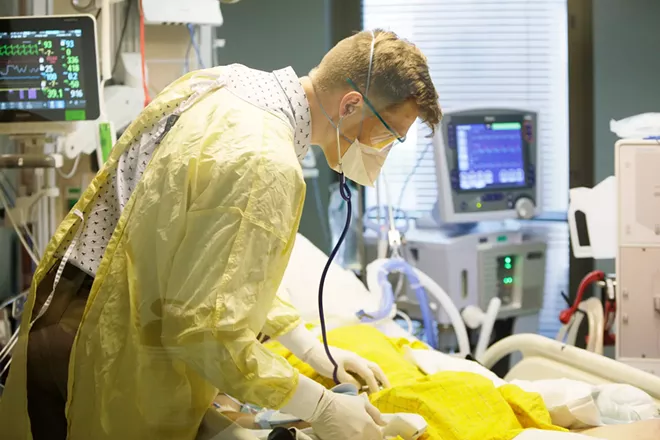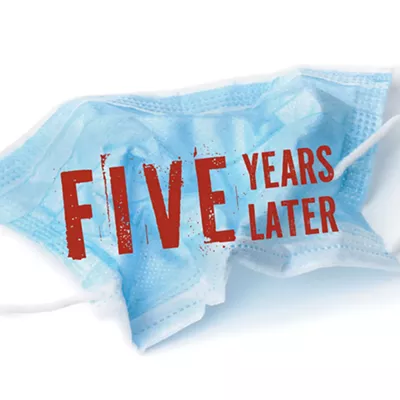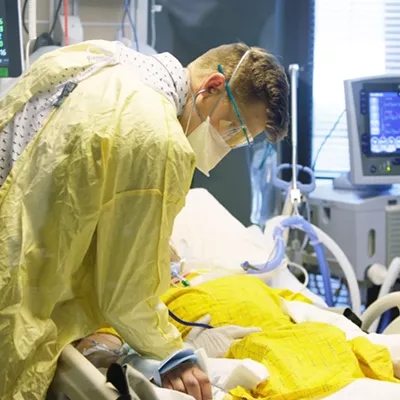
As the highly transmissible omicron variant impacts Eastern Washington and North Idaho, health care professionals are looking to Western Washington and other parts of the country to know what to expect.
Overall, the variant is reportedly affecting most people with milder symptoms, particularly those vaccinated who've received a booster.
But any time someone is hospitalized with COVID-19, that's serious, reminds Dr. Dan Getz, chief medical officer for Providence Sacred Heart and Holy Family hospitals in Spokane.
"We do worry that people are becoming complacent and calling omicron 'mild,'" Getz told reporters in an update last week. "Because we don't know as much about this variant, we should be cautious."
It will take time before omicron's true impacts are fully understood, but early indications suggest that it is likely to result in fewer deaths than previous variants, even as hospitalizations nationally hit a record level early this week. Global modeling from the University of Washington based on the experiences in other countries shows omicron could kill 97 to 99 percent fewer people than the delta variant, and may have a lower death rate (infection-fatality rate) than the flu.
However, the number of positive cases and hospitalizations are both likely to increase significantly in coming weeks because of how contagious omicron is. With more people infected, a significant number of people could still die.
Here's the outlook from local health officials.
TESTING
With record-setting daily case numbers in Spokane, some people have had a difficult time finding at-home tests, or have waited in line for hours to get the more-sensitive PCR tests at county testing sites. Making matters worse, winter weather closed the mountain passes for days last week, which meant that some retail stores were running out of supplies while waiting for trucks to arrive, and transportation of test samples to laboratories may have also been delayed.Heavy snow late last week also collapsed a tent at one of the two testing sites coordinated by the Spokane Regional Health District (SRHD) and staffed by Discovery Health MD, which are funded with money from the state Department of Health. Staff from the Spokane Falls Community College site temporarily relocated to the site at the Spokane County Fair and Expo Center. The two locations were expected to be running normally again this week.
SRHD is working with Discovery Health to expand the hours at both locations.
"Right now they're only open four days a week," Spokane Health Officer Dr. Francisco Velázquez tells the Inlander. "If we could get a weekend option, I think that would be great for the community."
The health district is also working on a contract with another testing company called Curative to expand options soon.
"They've done employer-based testing, they've done clinic-based testing, they also have kiosks," Velázquez says of Curative sites in other communities. "They also do PCR, rapid PCR and rapid antigen testing."
It's not clear yet what the final agreement with Curative will look like.
State and federal assistance could also soon provide thousands more at-home rapid tests to the Inland Northwest, though it's also unclear how long it could take for those to arrive.
The health district asked the state Department of Health for 5,000 rapid tests, which will be provided to at-risk community members first, Velázquez says. Washington Gov. Jay Inslee also announced the state has ordered 5.5 million at-home tests, which could go out to residents through an online ordering system piloted in Spokane County.
At the federal level, President Joe Biden promised a similar program will soon provide millions of rapid tests around the country.
In addition to getting tests through a clinic or health care provider, Spokane County residents can also call their local library branch to request a free test for curbside pickup, no library card required.
Schools also continue offering rapid tests and PCR tests to students, depending on the district. State guidelines for "test to stay" enable students with low-risk exposures to stay in class while getting tested. They receive an immediate test and then another test five days later, explains Mark Springer, epidemiologist with the Spokane health district. At least under previous waves, that worked well to keep students in school while the majority of them (as many as 99 percent) tested negative after exposure, he says.
HOSPITALIZATIONS
While omicron appears to be filling up hospitals in other parts of the country, it has not yet started flooding Inland Northwest hospitals. However, regional hospitals have maintained a steady flow of COVID-19 patients in recent months, and with winter illnesses, delayed surgeries finally taking place and other factors, they're already fairly full, according to hospital leaders.The biggest consideration for how "full" a hospital is comes down to having the staff members needed to care for the patients who are admitted.
As omicron starts to spread through the area, and more nurses and hospital staff may have to stay home due to their own illness or possible COVID exposure, hospital staffing levels could get more stressed, says Getz, with Providence in Spokane.
"Our hospitals are still dealing with many COVID-19 patients. I know nearly two years into this pandemic we're all sad and frustrated by it," Getz says. "What we're fearful of is if we start seeing increasing hospitalization rates for COVID, which we're seeing on the East Coast and into the Midwest, it's going to be really challenging to care for everybody at the same time."
On Monday, Jan. 10, Reuters reported that U.S. COVID hospitalizations hit 132,646, breaking the previous record high set last January.
"Our hospitals are still dealing with many COVID-19 patients. I know nearly two years into this pandemic we're all sad and frustrated by it."
DEATHS
It's hard to tell if the U.S. will fare as well as South Africa and other countries that already saw omicron sweep through their populations with low death rates compared to the massive number of positive cases.Health experts are warning that deaths could be higher in the U.S. because we have lower levels of people who've had COVID vaccine boosters than affected European countries like Denmark and the United Kingdom, as well as an older population than South Africa.
The New York Times also reported that even as the proportion of deaths to positive cases may be lower than previous waves, because omicron is so much more contagious and is likely to affect far more people, the overall number of deaths could remain significant.
Projections from the University of Washington's Institute for Health Metrics and Evaluation show daily deaths in the U.S. in coming weeks could be similar to the peak of the delta variant wave if omicron spread is severe.
STEPS TO TAKE
As has been the case throughout the pandemic, health officials urge people to take precautions to keep themselves and others who are at higher risk safe.The primary recommendation is to get vaccinated and get a booster when you're eligible.While it's still possible to get COVID after you've been vaccinated, the cases have been far less severe. Plus, as intended, the vaccines have largely prevented people from landing in the hospital or dying.
"I would like to just make sure we're all reminded we have a highly transmissible strain of the virus that is highly contagious," Velázquez says. "If you're eligible ... if you haven't gotten your booster, please do so. We do know that increases the protective effect to higher than 70 percent."
Likewise, it remains important to wear a mask that fits securely over your nose and mouth when you're around other people, maintain social distance when you're around people outside your household, and avoid large gatherings, he says.
If you have been exposed, Velázquez says to follow the new isolation recommendations from the CDC, which can be found at cdc.gov/covid19. ♦
Editor's Note: This story was corrected Thursday, Jan. 13, 2022, to reflect that SRHD actually helps coordinate the county testing sites that are staffed by Discovery Health, and the state Department of Health is the agency funding them.























